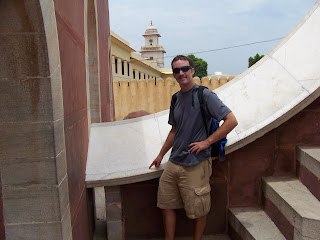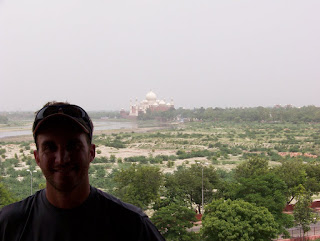I arrived in Kunming with 3 bags. One large duffel bag with my work clothes. One midsized day pack full of souvenirs and hiking supplies. One large backpack full of stuff for my week in Yunnan. I left the large duffel bag and the mid-sized pack at the Kunming airport when I flew to Shangri-La.
At the start of the hike, the weather did not look very good. I knew the trail was steep and slick, and I did not have a cover for my large pack. I had bought a tiny pack for US$8 in Shangri-La (where a bunch of North Face gear had "fallen off a truck" and was being sold for cheap). After much internal debate, I decided that I would leave my large pack at a guest house at the start of the trail, fit whatever I could into the small bag, and go with that.
So in addition to what I wore and had in my pockets, I brought for the hike:
1 spare pair of socks, 1 spare pair of underwear, a poncho, 4 clif bars, 4 half liter bottles of water, a book, my passport, a few pages describing the hike torn out of the Lonely Planet, about Y600, and a couple credit cards.
Notable items not on this list include (among other things):
Head lamp, advil, celebrex, spare clothes, a knife, dry shoes or sandals, my wallet.
The last object is particularly noteworthy since I was paid by Kijiji in cash (no electronic payments possible from China to US). So I have a few thousand dollars cash balled up in the bottom of my pack. I decided to leave it in my big pack because my day pack had absolutely no place to hide it. I decided it would be safer stuffed in the bottom of a dirty old pack at the start of the trail, since the Lonely Planet mentioned that solo foreign travelers should beware of thieves.
Until the avalanche came, scattering my belongings all around Yunnan to save weight seemed brilliant. But the landslide blocked the only road between the end of the hike and the start of the hike. Note the map below: The trail is in gray, the only road in black, the river through the gorge is in blue, and the landslide is in red. I am at the end of the hike. My stuff is at the start of the hike. I need to go to Lijiang.

It quickly dawned on me that I was in the middle of nowhere in Yunnan China, knew nobody, had a cell phone that didn't work, did not speak Chinese, was soaking wet, and all I had with me was about $50, a pair of dirty socks and underwear, and 1 last clifbar.
I hiked as fast as my tired legs would go uphill to a little cafe at the end of the hike. I got there around 12:30. There were 7 other travelers there including my new friend from Guangdong Province, another guy who turned out to be from Beijing, and 5 Israelis. I immediately attached myself to the hip of the two Chinese speakers.
After about 30 minutes of discussing the situation, we decided to hire a car for Y5 each to take us to the landslide. We would see if we could walk through it. If we could, we would hire a car on the other side to take us to the start of the hike. This seemed like a reasonable enough plan, so I hopped in a minivan (sidenote: the chinese word for minivan is loaf-of-bread-car) with the two chinese guys. The Israelis argued for about 20 minutes and finally 3 of them decided to come with us, leaving the other 2 temporarily at the cafe.
We headed off on the crazy, windy road with no guardrails and 2,000 foot sheer drops towards the landslide. Along the way, we passed about 3 small landslide areas any one of which undoubtedly would have closed any road in the US. We barely slowed down to avoid the boulders and waterfalls. Then, we saw it: the entire road was covered for about 30 yards with huge boulders. Definitely no cars getting through.

We got out to inspect the situation. It might have been possible to scamper through the landslide to the other side. The big problem was that there was still rocks that kept falling. Little rocks and dirt were falling continuously and would have made the ground very slick. Rocks about the size of a person's head fell every few seconds. They could probably be avoided, but if they hit you, they would definitely knock you off the cliff. And every few minutes, person-sized boulders would tumble down.
After discussing the situation for a few minutes, we decided to turn back. To punctuate the decision, a huge rock fell about 10 feet from where we were standing on the road. We quickly got back in the minivan and returned to the cafe. A mid-sized rock bounced off the side of the van as we drove off.
Along the way back to the cafe, I was discussing the situation with my new best friend from Guangdong. I told him that I needed to get back to the start of the hike to get my pack, so maybe I would just hike back. While walking 8 hours back to the start of the trail seemed far less than ideal, I couldn't come up with any better options. He suggested that I call the cafe at the start of the trail and have them send my bag to Lijiang. I was amazed at this idea. He explained the idea to the woman at the end of the trail cafe. She called the woman at the cafe at the start of the trail. After about 10 minutes of discussion, they said that I could pick up my bag that night at "Mama's" Guesthouse in Lijiang. It would cost me 15 Yuan (US$1.95) for the delivery. I quickly accepted the offer. Now all I had to do was get to Lijiang (and hope my bag did too).
Back at the cafe, I stayed as close to the lone minivan as possible. A few more travelers arrived and were also trying to sort out the situation. There were rumors that we could take a car to a ferry, take the ferry across the river, then try to find a car on the other side to take us to Lijiang. The two Chinese guys arranged for the minivan to drive us to this ferry crossing, so I hop in again. The Israeli's again tried to figure out how to split up. In the meantime, I met a white American guy! This was the first American I had met in 5 days in Yunnan. We got to talking and it turned out he is a CS Masters student at Stanford (Sergey) who was traveling with 2 Chinese-American Stanford girls (Carri and Diane)! I told them to quickly get in the van, we ditched the still arguing Israelis, and took off.
We drove along about 30 minutes mostly on these dirt farm roads through some corn fields vaguely towards the river. Eventually, the path ended, and the driver said we should get out. We paid him Y10 each, he pointed off in the distance, and said it is 500 meters to the water. We set off.

After nearly an hour of uncertain hiking (definitely more than 500 meters), we reached the cliffs and followed a winding path down to the river. Across the river, we could see a boat and a few caves where it looked like somebody could live. After a few minutes of yelling, a ferryman woke up, came down to the river, and brought his boat across the river to get us.

We took the ferry across the river for Y15.

On the other side, we climbed up a trail from the water to a dirt road. We followed this dirt road for about 30 minutes towards a cluster of buildings that was supposedly a village. Finally, we got to the first building which was a guesthouse. By now it was about 4:30. The two Chinese guys decided to spend the night at the guesthouse and take a bus the next morning to Shangri-La. The Stanford kids and I both wanted to get to Lijiang. There were no more buses. But the owner of the guesthouse eventually said that the village's one car could be hired to drive us to Lijiang for Y300 at 7pm. We accepted.

Still though, we had almost 3 hours to kill, so we wandered into "town". This was as stereotypical a Chinese village as you can imagine. One dirt road through town with a few shacks surrounding it. Chickens wandering in the street, a few donkeys, etc. The little kids all ran into the street and wave and yell at me and Sergey (I imagine not many white travelers make it in these parts). We did not see any cars for about 30 minutes.

Suddenly, a mini-bus rumbled down the street towards us. We flagged it down. After about 2 minutes of amazing negotiation by Diane, the mini-bus driver agreed to take us right then to Lijiang for Y300. We immediately jumped in and we took off, ecstatic that success was finally in sight.
A few small adventures later (we switched cars once and drivers twice for no apparent reason), we finally arrived after about 3 hours on bumpy dirt roads at Lijiang around 8pm. I found my way to "Mama's" within about 20 minutes, and sure enough my backpack was there, contents entirely intact! I have no idea how it got there.
Total cost of the trip: Y5 (car 1) + Y10 (car 2) + Y15 (ferry) + Y75 (bus) + Y15 (bag) = Y120 or about $15.
We decided to celebrate that night at a local bar which was of course named "The Sexy Tractor". And obviously, the bartender was a Chilean guy who used to live in Brazil. I told him I lived in Sao Paulo for a while, and we talked in Portunol for a bit. He pulled out some Cachaca from underneath the counter and made me an awesome caiprinha. Amazing end to a crazy day.


















































